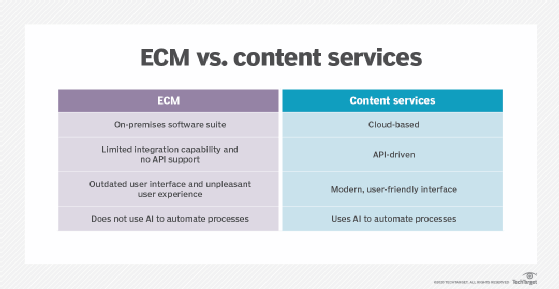enterprise content services
Enterprise content services are the evolution of enterprise content management (ECM); their goal is to adapt to the changing needs of enterprises and the emergence of new technologies, such as cloud computing. ECM can be considered both a mission and a technology. Their mission is to provide a centralized platform for records management (RM) and the storage and distribution of business information, as well as support regulatory compliance and risk management. The technology to support that mission has continued to grow over the years and has become an inflexible and huge platform that is unable to adapt and deliver users' needs and expectations, thus making the transformation into content services necessary.
In a 2017 research report, research and consultancy firm Gartner marked the end of ECM, giving way to what they called enterprise content services. In a clear response to the emergence of cloud computing, Gartner defines enterprise content services as a set of services and microservices that can operate as both an integrated suite or as separate, but integrated applications.
Previously, Gartner tracked the ECM vendor landscape in a Magic Quadrant report. Now, they publish a Magic Quadrant for Content Services Platform, which they continue to update.
With ECM, organizations were required to purchase a massive suite of capabilities, even if they only needed a small subset of them. Enterprise content services, on the other hand, provide a customizable approach to purchasing and using isolated capabilities, sometimes from multiple vendors. Enterprise content services share common repositories via application program interfaces (APIs), supporting a wide range of content types and use cases.
Today, organizations don't rely on a single repository, but a growing array of them -- including Dropbox, Box, Microsoft SharePoint and Google Drive. Enterprise content services provide API-driven microservices to connect these repositories to related business applications. They support an adaptable framework that easily integrates with new applications and gives users the flexibility they need.
Elements of content services
Gartner defines content services as having three elements:
Content services platforms represent the evolution of inflexible ECM suites. Content services platforms provide their own content repository, but also integrate with other repositories via APIs. Content services platforms provide tools that support a core set of common use cases, such as information management, workflow, version control and analytics.
Content services applications provide use cases that are more specific than the core set provided by content services platforms. Examples include applications tailored to vertical industries, as well as contracts management and invoice management.
Content services components provide additional features on top of existing applications and core feature sets. Example features include document capture and language translation.
Content services platforms vs. ECMs
In defining the shift from enterprise content management to enterprise content services, Gartner emphasized the move away from a central repository as the focal point of the solution. The solution is no longer about the sheer storage of content, but how the content is used by individuals to collaborate and share, as well as create business processes to drive insights.
There are additional differences between content services and ECMs, including:
On-premises vs. cloud. The majority of ECMs were delivered as inflexible, on-premises software suites. Content services, on the other hand, use modern, cloud-based technologies, including microservices.
API-centric. While ECMs provided limited integration capability and no API support, content services are API-driven, using a common set of REST APIs to retrieve and access content across multivendor repositories.
User interface and user experience. Many ECMs were designed 10 to 15 -- or more -- years ago and employ outdated user interfaces (UI) which create poor user experiences (UX). Content services, on the other hand, have modern, user-friendly interfaces that maximize productivity for end users and optimize the user experience.
Artificial Intelligence (AI). Unlike ECMs, content services employ artificial intelligence to perform automated classification and tagging of content -- using natural language processing (NLP). Predictive analytics are also used to help automate workflows and processes that are traditionally handled manually.

Benefits of content services
Enterprise content services offer the following benefits:
Convenient and easy access to content. With ECM, all content was centralized in a single repository. If business users needed a document or file, they would search and access that repository. Content services, on the other hand, support an interconnected world of repositories. Using APIs, content is delivered to users wherever they happen to be, rather than forcing users to go find the content in the one repository.
Flexibility and choice. Content services give users choices about where content is stored and accessed. Its API-driven architecture provides the flexibility of integrating additional systems and tools from multiple vendors. If an "out of the box" integration is not available, the platform can be easily developed using the API.
Cost savings. ECMs are high-cost, inflexible software systems that require a significant hardware investment. Content services, on the other hand, are provided using lightweight, cloud-native microservices. The tools are delivered as a service, with no hardware investment required. Further cost savings can be found in the separation of capabilities, since organizations can purchase only the features they need.